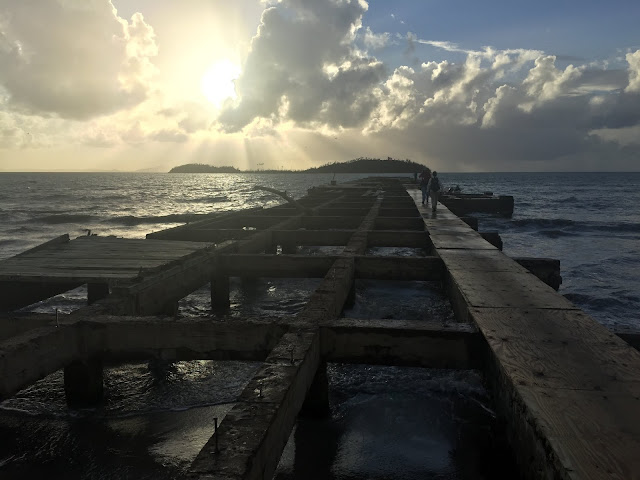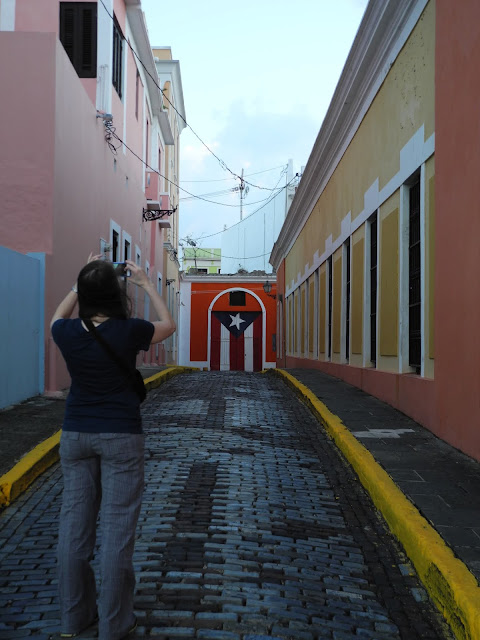In late December of 2017, just after Christmas, we visited Monkey Island, a small island off a bigger island in the middle of the Caribbean. The Caribbean islands as a whole have not had native primate species for some time, but some number of decades ago that changed. A population of rhesus macaques was brought to Cayo Santiago just off the southeastern coast of Puerto Rico to establish a research colony for primate research at the nearby Caribbean Primate Research Center. Our visit was just a short while after Hurricane Maria and the research center, nearby town of Punta Santiago, and monkey island had all been hit hard.
Our trip was part of a greater series of relief efforts which would slowly help rebuild some of the town and research center. The island itself had few permanent pre-storm structures -- the monkeys had never gotten around to building any themselves -- but the few that existed were mostly blown over or, in many cases, damaged beyond repair. Thankfully the dock which is the only means of shepherding supplies to and from the larger island remained intact. Although it is always difficult to do accurate counts given there are estimated to be 1,000+ macaques broken down into a number of mobiles groups on the island at any given time, it is estimated that only a few monkeys perished during and after the storm. Shortly after the hurricane passed the first priority was repairing Punta Santiago's dock that served as the point of departure for the daily monkey chow to the island as its vegetation and limited resources cannot support the monkeys long. This was completed by the time we arrived -- though there were still many gaps in the planks and missing boards. Our task was to help with debris clearance in anticipation of the future rebuild.
For two days we ferried over to the island and hauled twisted metal and splintered wood from one place to another. It was hot and humid even in December, and, with a few older individuals participating in the venture, we took far more breaks than probably were warranted, but nevertheless we succeeded in moving individual pieces of debris into huge piles of debris for latter shuttling off the island. Along the way we were occasionally followed by monkeys, but typically more often we were ignored completely. There was a little bit of monkey sex and a bit more monkey fighting and that was it. Aside from monkey chow time -- when the monkeys would swarm and stuff as many monkey biscuits into their hands, tails, and pockets as possible before running off awkwardly on their hind legs -- and periodic monkey migrations -- when a large herd of seemingly endless monkeys would move en masse for presumably brilliant monkey reasons -- the monkeys were more scenery than major players in our Monkey Island visit. Which is probably good because they can both be ornery and disease vectors which is never a good combination (see Herpes B virus). Interspersed amongst the monkeys were a number of iguanas that seemed equally indifferent to the presence of either of us. The most surprising aspect of our trip to Monkey Island was actually not the fauna but the flora. Or rather the lack of it. While once tropical and green the storm winds had stripped most of the leaves from the palms that typically provided cover and a once shaded island was now quite sun exposed. This was true not just of Monkey Island, but much of Puerto Rico as a whole. The power of the hurricane was still clearly visible even 3 months later.
Our work on Monkey Island aside we also helped repair some roofs, scrub mold off a ceiling -- or at least tried to, and pulled up soggy old flooring from nearby homes. There were thankfully folks with better carpentry skills than our own so hopefully the efforts are lasting. Local accommodations were provided at a hotel in the capital which was almost entirely occupied by electrical workers and individuals from various governmental and nongovernmental organizations. Although the country side and city of San Juan were not as destroyed as I had feared, the impact was still clearly present as the destruction of the island's power grid led to regular power shortages even a hundred days later and traffic lights that still didn't function. We also visited with a friend of Liz's, Nicky, who worked at the primate center and lived in a nice little town home nearby. We toured some of the nearby beaches, visited Old San Juan -- which I think is a beautiful gem of a historical town -- and ate a good number of plantains in its various incarnations. Although not a huge fan of mofongo I will never turn down a good fried plantain. 😃💟🍌






